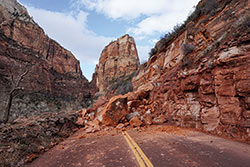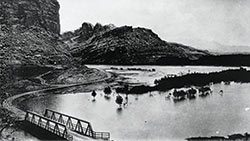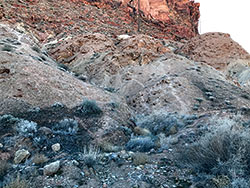 |
| A rockfall in Zion National Park in 2017. Zion contains steep slopes and the Navajo Sandstone, one of the rock layers also found near Moab. It has a significant rockfall hazard similar to that in southeastern Utah. Courtesy of the Utah Geological Survey. |
The idea that geology is static is something that pervades much of popular culture. The phrases “as solid as the Earth under your feet” or “those everlasting hills” resonate with us humans because our timescales are much shorter than the expanses of geologic time. Because much of the geologic history of most regions, such as the Colorado Plateau here in southeastern Utah, took place in the deep geologic past that consists of millions—or even tens or hundreds of millions—of years, it may seem as if geology is only about the past.
Yet, the Earth is still an active, dynamic planet. Continents are on the move, volcanoes erupt, the ground shakes when jolted by movement along faults, and earth, rock, and soil may cascade downhill under the pull of gravity.
Geohazards (geological hazards) result from active geologic processes, whether they are rapid, or slow or gradual. Geohazards may be catastrophic or less severe. They may impact large regions or be very localized. And they may cause harm or damage to people, infrastructure (buildings, roads, bridges, etc.), or both.
Geohazards vary from place to place because they relate to local geology. For example, while Hawai’i has volcanic and tsunami hazards, Moab does not. But both areas have rockfalls and landslides.
The main geohazards in Southeastern Utah are in three general categories: flooding, rockfall and other types of mass movements, and those related to the properties and characteristics of the bedrock, unconsolidated sediment, or soil present. Together, the geohazards of the Moab area mostly are a product of climate, bedrock geology, and the fact that southeastern Utah is a young geological landscape as evidenced by the presence of steep slopes and significant topographic relief.
 |
| Colorado River flood at the mouth of Courthouse Wash in 1917.
Photo courtesy of the Moab Museum
(Southeastern Utah Society of Arts and Sciences) |
Flooding is a nearly ubiquitous geohazard that probably impacts more people and more land area worldwide than any other geological hazard. Flooding along the Colorado and Green rivers generally results from heavy spring runoff from the mountain headwaters, whereas flash flooding occurs in streams and otherwise dry washes after heavy rainfall events. The steep gradients found throughout southern Utah can give flash flood events great erosive strength. Wildfires like the June 2021 Pack Creek Fire in the La Sal Mountains increase the likelihood of flash floods since burned areas are less able to absorb rain water.
Mass movements consist of the movement of rock and earth material downhill under the influence of gravity. Rockfall is one of the major processes that shape cliffs throughout southeastern Utah. The presence of joints (fractures) provides planes of weaknesses that facilitate rockfall, as does the presence of weaker rock layers (formations to geologists) like the Chinle Formation. Softer layers can literally undercut harder rock layers above them above them as erosion proceeds. Evidence that rockfall plays in shaping the landscape is present in the rocky debris aprons covering the slopes beneath canyon country’s miles of cliffs.
 |
| Paradox Formation caprock exposed near the Portal near the Kane Creek Road. The Paradox Formation here consists mostly of contorted gypsum left after salt dissolution. |
Another significant source of geohazards in Moab-Spanish Valley is the presence of salt, other evaporite minerals, and swelling clays in some of rock layers in the Moab region. The Paradox Formation was deposited in a hypersaline seaway and contains thick expanses of salt, potash, and gypsum. Sinkholes can form in soils containing these minerals, and these soils are also highly susceptible to erosion. They even can be corrosive to concrete and other building materials.
Swelling clays (like bentonite) are present in the Chinle, Morrison, and Mancos Shale formations. These clays are tough on infrastructure causing roads to heave and damage to buildings.
Some of the geohazards that are present are not immediately evident. For example, the Moab-Spanish Valley area has high radon hazard. Radon is an odorless radioactive gas created during the radioactive decay of uranium. It can enter homes and other buildings by seeping up through the soil. Prolonged exposure to radon can cause lung cancer, making it the deadliest geohazard in the state of Utah, having caused more than 90% of the states’ documented geohazard-related fatalities. Radon hazard is generally only a concern in buildings because it naturally dissipates outdoors. Radon concentrations can vary from house-to-house due to small differences in geology, building construction, and other factors, and can be reduced through mitigation.
It’s easy to overlook the presence of geohazards in southeastern Utah, especially on a sunny spring day with wildflowers starting to bloom. Particularly given the absence of the most obvious geohazards like volcanoes and the distance to the seismically-active Wasatch Front. But an awareness of geohazards can help protect life and property, and can also be a reminder that geology is also about the here and now, versus only being about the there and then (e.g., the ancient geological past).
-----
In 2018, the Utah Geological Survey released a publication on the geologic hazards of the Moab Quadrangle which identified 13 geohazards. The Moab Quadrangle geohazards report is available at https://geology.utah.gov/hazards/.
|